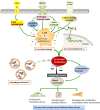Lysosomal dysfunction-induced autophagic stress in diabetic kidney disease
- PMID: 32583573
- PMCID: PMC7412686
- DOI: 10.1111/jcmm.15301
Lysosomal dysfunction-induced autophagic stress in diabetic kidney disease
Abstract
The catabolic process that delivers cytoplasmic constituents to the lysosome for degradation, known as autophagy, is thought to act as a cytoprotective mechanism in response to stress or as a pathogenic process contributing towards cell death. Animal and human studies have shown that autophagy is substantially dysregulated in renal cells in diabetes, suggesting that activating autophagy could be a therapeutic intervention. However, under prolonged hyperglycaemia with impaired lysosome function, increased autophagy induction that exceeds the degradative capacity in cells could contribute toward autophagic stress or even the stagnation of autophagy, leading to renal cytotoxicity. Since lysosomal function is likely key to linking the dual cytoprotective and cytotoxic actions of autophagy, it is important to develop novel pharmacological agents that improve lysosomal function and restore autophagic flux. In this review, we first provide an overview of the autophagic-lysosomal pathway, particularly focusing on stages of lysosomal degradation during autophagy. Then, we discuss the role of adaptive autophagy and autophagic stress based on lysosomal function. More importantly, we focus on the role of autophagic stress induced by lysosomal dysfunction according to the pathogenic factors (including high glucose, advanced glycation end products (AGEs), urinary protein, excessive reactive oxygen species (ROS) and lipid overload) in diabetic kidney disease (DKD), respectively. Finally, therapeutic possibilities aimed at lysosomal restoration in DKD are introduced.
Keywords: autophagic stress; autophagy; diabetic kidney disease; lysosomal dysfunction.
© 2020 The Authors. Journal of Cellular and Molecular Medicine published by John Wiley & Sons Ltd and Foundation for Cellular and Molecular Medicine.
Conflict of interest statement
All authors declare that they have no conflicts of interest.
Figures



Similar articles
-
Autophagy-Lysosome Pathway in Renal Tubular Epithelial Cells Is Disrupted by Advanced Glycation End Products in Diabetic Nephropathy.J Biol Chem. 2015 Aug 14;290(33):20499-510. doi: 10.1074/jbc.M115.666354. Epub 2015 Jun 22. J Biol Chem. 2015. PMID: 26100632 Free PMC article.
-
Autophagy Inhibits the Accumulation of Advanced Glycation End Products by Promoting Lysosomal Biogenesis and Function in the Kidney Proximal Tubules.Diabetes. 2017 May;66(5):1359-1372. doi: 10.2337/db16-0397. Epub 2017 Feb 28. Diabetes. 2017. PMID: 28246295
-
Lysosome restoration to activate podocyte autophagy: a new therapeutic strategy for diabetic kidney disease.Cell Death Dis. 2019 Oct 24;10(11):806. doi: 10.1038/s41419-019-2002-6. Cell Death Dis. 2019. PMID: 31649253 Free PMC article.
-
Regulation of autophagy by natural polyphenols in the treatment of diabetic kidney disease: therapeutic potential and mechanism.Front Endocrinol (Lausanne). 2023 Aug 10;14:1142276. doi: 10.3389/fendo.2023.1142276. eCollection 2023. Front Endocrinol (Lausanne). 2023. PMID: 37635982 Free PMC article. Review.
-
Role of Impaired Nutrient and Oxygen Deprivation Signaling and Deficient Autophagic Flux in Diabetic CKD Development: Implications for Understanding the Effects of Sodium-Glucose Cotransporter 2-Inhibitors.J Am Soc Nephrol. 2020 May;31(5):907-919. doi: 10.1681/ASN.2020010010. Epub 2020 Apr 10. J Am Soc Nephrol. 2020. PMID: 32276962 Free PMC article. Review.
Cited by
-
Protective effect of the tunneling nanotube-TNFAIP2/M-sec system on podocyte autophagy in diabetic nephropathy.Autophagy. 2023 Feb;19(2):505-524. doi: 10.1080/15548627.2022.2080382. Epub 2022 Jun 6. Autophagy. 2023. PMID: 35659195 Free PMC article.
-
Tear proteomics reveals expressed proteins and potential pathways associated with diabetic keratopathy.Eye (Lond). 2025 Sep;39(13):2570-2578. doi: 10.1038/s41433-025-03919-7. Epub 2025 Jul 15. Eye (Lond). 2025. PMID: 40664763
-
Association between continuous glucose monitoring-derived glycemic control indices and urinary biomarkers of diabetic kidney disease: Hyogo Diabetes Hypoglycemia Cognition Complications study.Acta Diabetol. 2024 Apr;61(4):413-423. doi: 10.1007/s00592-023-02214-9. Epub 2023 Nov 25. Acta Diabetol. 2024. PMID: 38006524 Free PMC article.
-
Cordyceps cicadae Ameliorates Renal Hypertensive Injury and Fibrosis Through the Regulation of SIRT1-Mediated Autophagy.Front Pharmacol. 2022 Feb 10;12:801094. doi: 10.3389/fphar.2021.801094. eCollection 2021. Front Pharmacol. 2022. PMID: 35222012 Free PMC article.
-
Novel Insights into Diabetic Kidney Disease.Int J Mol Sci. 2024 Sep 23;25(18):10222. doi: 10.3390/ijms251810222. Int J Mol Sci. 2024. PMID: 39337706 Free PMC article. Review.
References
-
- Zhang L, Long J, Jiang W, et al. Trends in chronic kidney disease in China. N Engl J Med. 2016;375:905‐906. - PubMed
-
- Jefferson JA, Shankland SJ, Pichler RH. Proteinuria in diabetic kidney disease: a mechanistic viewpoint. Kidney Int. 2008;74:22‐36. - PubMed
-
- Warren AM, Knudsen ST, Cooper ME. Diabetic nephropathy: an insight into molecular mechanisms and emerging therapies. Expert Opin Ther Targets. 2019;23:579‐591. - PubMed
Publication types
MeSH terms
Substances
LinkOut - more resources
Full Text Sources
Medical

